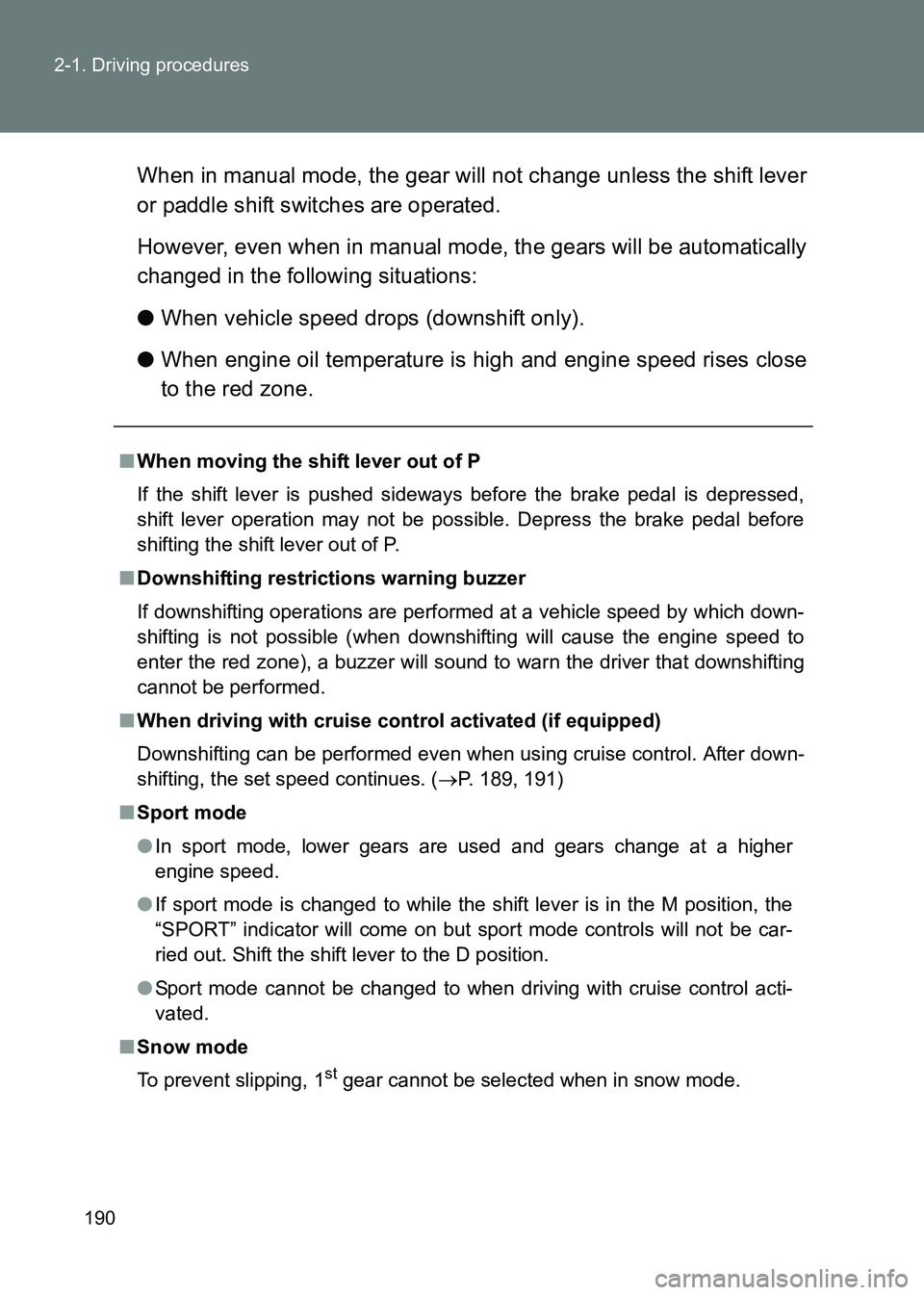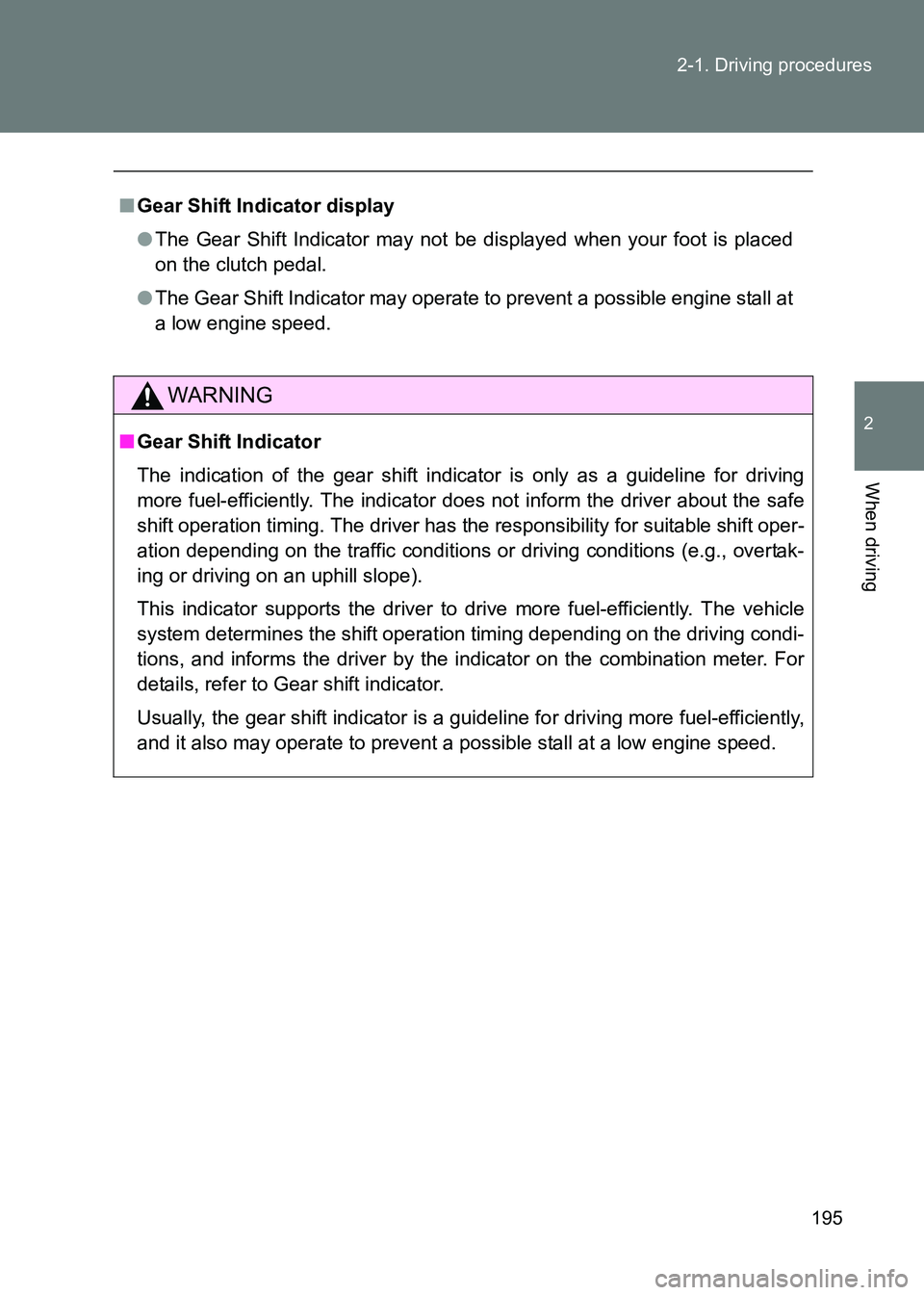Page 185 of 505

185
2-1. Driving procedures
2
When driving
86_EE (OM18071E)
WARNING
■
When starting the engine
Always start the engine while sitting in the driver's seat. Do not depress the
accelerator pedal while starting the engine under any circumstances.
Doing so may cause an accident resulting in death or serious injury.
■ Caution when driving
Do not turn the engine switch to the “LOCK” position while driving. If, in an
emergency, you must turn the engine off while the vehicle is moving, turn the
engine switch only to the “ACC” position to stop the engine. An accident may
result if the engine is stopped while driving. ( →P. 469)
NOTICE
■To prevent battery discharge
Do not leave the engine switch in the “A CC” or “ON” position for long periods
of time without the engine running.
■ When starting the engine
●Do not crank the engine for more than 10 seconds at a time. This may
overheat the starter and wiring system.
If the engine does not start, turn the engine switch to the “LOCK” position
and try to start the engine again after waiting for 10 seconds or more.
● Do not race a cold engine.
● If the engine becomes difficult to start or stalls frequently, have your vehi-
cle checked by any authorized Toyota dealer or repairer, or another duly
qualified and equipped professional immediately.
Page 190 of 505

190
2-1. Driving procedures
86_EE (OM18071E)
When in manual mode, the gear will not change unless the shift lever
or paddle shift switches are operated.
However, even when in manual mode, the gears will be automatically
changed in the following situations:
●
When vehicle speed drops (downshift only).
● When engine oil temperature is high and engine speed rises close
to the red zone.
■When moving the shift lever out of P
If the shift lever is pushed sideways before the brake pedal is depressed,
shift lever operation may not be possible. Depress the brake pedal before
shifting the shift lever out of P.
■ Downshifting restrictions warning buzzer
If downshifting operations are performed at a vehicle speed by which down-
shifting is not possible (when downshifting will cause the engine speed to
enter the red zone), a buzzer will sound to warn the driver that downshifting
cannot be performed.
■ When driving with cruise control activated (if equipped)
Downshifting can be performed even when using cruise control. After down-
shifting, the set speed continues. ( →P. 189, 191)
■ Sport mode
●In sport mode, lower gears are used and gears change at a higher
engine speed.
● If sport mode is changed to while the shift lever is in the M position, the
“SPORT” indicator will come on but sport mode controls will not be car-
ried out. Shift the shift lever to the D position.
● Sport mode cannot be changed to when driving with cruise control acti-
vated.
■ Snow mode
To prevent slipping, 1
st gear cannot be selected when in snow mode.
Page 192 of 505

192
2-1. Driving procedures
86_EE (OM18071E)
■
AI-SHIFT
The AI-SHIFT automatically shifts the gear to the suitable position according
to the driver performance and driving conditions.
The AI-SHIFT automatically operates when the shift lever is in the D posi-
tion. (Operating the paddle shift switches or shifting the shift lever to the M
position cancels the function.)
WARNING
■When driving on slippery road surfaces
Be careful of downshifting and sudden acceleration, as this could result in
the vehicle skidding to the side or spinning.
■ To prevent incorrect operation
Do not attach items such as accessories to the paddle shift switches.
Doing so may unintentionally move the paddle shift switches.
■ Gear Shift Indicator
The indication of the gear shift indica tor is only as a guideline for driving
more fuel-efficiently. The indicator does not inform the driver about the safe
shift operation timing. The driver has t he responsibility for suitable shift oper-
ation depending on the traffic conditions or driving conditions (e.g., overtak-
ing or driving on an uphill slope).
This indicator supports the driver to dr ive more fuel-efficiently. The vehicle
system determines the shift operation timing depending on the driving condi-
tions, and informs the driver by the indicator on the combination meter. For
details, refer to Gear shift indicator.
Page 195 of 505

195
2-1. Driving procedures
2
When driving
86_EE (OM18071E)
■
Gear Shift Indicator display
●The Gear Shift Indicator may not be displayed when your foot is placed
on the clutch pedal.
● The Gear Shift Indicator may operate to prevent a possible engine stall at
a low engine speed.
WARNING
■Gear Shift Indicator
The indication of the gear shift indica tor is only as a guideline for driving
more fuel-efficiently. The indicator does not inform the driver about the safe
shift operation timing. The driver has t he responsibility for suitable shift oper-
ation depending on the traffic conditions or driving conditions (e.g., overtak-
ing or driving on an uphill slope).
This indicator supports the driver to dr ive more fuel-efficiently. The vehicle
system determines the shift operation timing depending on the driving condi-
tions, and informs the driver by the indicator on the combination meter. For
details, refer to Gear shift indicator.
Usually, the gear shift indicator is a guidel ine for driving more fuel-efficiently,
and it also may operate to prevent a possible stall at a low engine speed.
Page 203 of 505
203
2-2. Instrument cluster
2
When driving
86_EE (OM18071E)
NOTICE
■
To prevent damage to the engine and its components
●Do not let the indicator needle of the tachometer enter the red zone, which
indicates the maximum engine speed.
● In the following situations, the engine may be overheating. In this case,
immediately stop the vehicle in a safe place, and check the engine after it
has cooled completely. (
→P. 464)
• Vehicles with a monochrome multi-information display: The engine coolant temperature gauge enters the red zone
• Vehicles with a color multi-inform ation display: The high engine coolant
temperature warning light flashes or illuminates
Page 204 of 505
204
2-2. Instrument cluster
86_EE (OM18071E)
Indicators and war ning lights
The indicator and warning lights on the instrument cluster and cen-
ter panel inform the driver of the status of the vehicle’s various sys-
tems.
For the purpose of explanation, the following illustration displays all
indicators and warning lights illuminated.
Instrument cluster (with monochrome display)
Instrument cluster (with color display)
Page 208 of 505

208
2-2. Instrument cluster
86_EE (OM18071E)
■
Warning lights
Warning lights inform the driver of malfunctions in any of the
vehicle’s systems. ( →P. 395, 404)
*1:Vehicles without a smart entry & start system
These lights turn on when the engine switch is turned to the “ON”
position to indicate that a system check is being performed. They
will turn off after the engine is started, or after a few seconds. There
may be a malfunction in a system if a light does not come on, or if
the lights do not turn off. Have the vehicle inspected by any autho-
rized Toyota dealer or repairer, or another duly qualified and
equipped professional for details.
Vehicles with a smart entry & start system
These lights turn on when the “ENGINE START STOP” switch is
turned to IGNITION ON mode to indicate that a system check is
being performed. They will turn off after the engine is started, or
after a few seconds. There may be a malfunction in a system if a
light does not come on, or if the lights do not turn off. Have the vehi-
cle inspected by any authorized Toyota dealer or repairer, or
another duly qualified and equipped professional for details.
*2: The light flashes in yellow to indicate a malfunction. The light flashes quickly in green to indicate that the steering lock has not
been released.
*3: The light comes on in yellow to indicate a malfunction.
(Red)(If equipped)(If equipped)(Yellow)
(If equipped)(Yellow)(If equipped)
(for driver)(for the
front pas- senger)
(If equipped)(If equipped)
*1*1*1*1*1*1*1
*1*1*2*3*1*1
*1*1*4*1
Page 209 of 505
209
2-2. Instrument cluster
2
When driving
86_EE (OM18071E)
WARNING
■
If a safety system warning light does not come on
Should a safety system light such as the ABS and SRS warning light not
come on when you start the engine, this could mean that these systems are
not available to help protect you in an accident, which could result in death
or serious injury. Have the vehicle inspected by any authorized Toyota dealer
or repairer, or another duly qualifi ed and equipped professional immediately
if this occurs.
*4: Vehicles with a monochrome multi-information display only: This light turns on when the engine switch is turned to the “ON” position
to indicate that a system check is being performed. It will turn off
after the engine is started, or after a few seconds. There may be a
malfunction in a system if the light does not come on or turn off.
Have the vehicle inspected by your Toyota dealer for details.